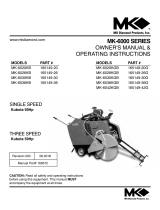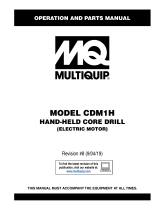
12
BD7 OIL/COOLANT
Roc Cut
Roc Cut from Diamond Pacic is a new synthetic water soluble cutting additive with rust inhibitors. Mix 30 to 1 (water to
Roc Cut).
Never run a diamond blade dry as this can immediately damage your blade. Use one of the oils/coolants recommended
below. Coolant should be kept clean and below 100° F. Sludge should be removed periodically and replaced with fresh
coolant so that your cuts will be clean and your blades will not be damaged.
Non-hazmat replacement oil for electrical transformer cooling. Excellent lubricating properties for blades and saw parts.
Flushes sludge from rock easily, degreases easily, and sludge settles in saw tank well. In Southern California, Shell Diala
Ax can be purchased from Dion and Sons, Inc (www.dionandsons.com).
Food grade mineral oil. Non-hazardous lubricating oil for bakeries, breweries and food processing machinery. Good lubri-
cating properties, degreases and settles sludge well. Can go rancid over time (1 year or less).
Food grade mineral oil, excellent for slab sawing in all our slab saws.
Pure petroleum based machining cutting oil. Good for slab sawing but very strong odor. Often the cheapest priced oil
available but odor is tough to eliminate.
Ethylene glycol based automotive antifreeze and its vapors are considered hazardous and toxic. Propylene glycol based
antifreeze is nontoxic but has practically no lubricating properties; it functions as a coolant only and its use will lead to
rapid blade wear and dulling.
Does not have adequate lubricating proprieties for our saws; vapors are considered hazardous and toxic.
Synthetic water based cutting agaent (mix ratio 2oz per gallon).
Water soluable synthetic coolants (i.e. Valenite or Cimtool) are often mixed in a 20:1 blend with water. Fluid vapors are
considered hazardous. These uids do not have adequate lubricating or rust inhibiting properties for the cast iron and
steel parts in our slab and trim saws.
Very ammable with a low ash point. At least 3 of our commercial cutting customers in Arizona and Pacic Northwest
have burned down their shops using these uids. Can be very tough to degrease the residue and aroma out of the cut
slabs. These uids are cheap, but very hazardous to use. Diesel is a benzene compound which is carcinogenic. All these
uids can cause severe skin rashes and other ailments.
Shell Diala Ax and Amber Neutral 100
Chevron Superla #5
AVATEC 80
Texaco ALMAG
Automotive Antifreeze Coolant
Automotive Transmission Fluid
Smokey's EZ Cut
CNC Machining Fluids
Diesel, Heating Oil and Kerosene
Electrical transformer cooling oil. A highly rened petroleum product, available from some non-Shell oil distributors, typi-
cally only in 55 gallon drums. Same properties and performance as Shell Amber Neutral 100.
Hyvolt II
A chlorine-free cutting oil with reduced sulfur and fat content. Light in color and low in odor.
Chevron Texaco Bright-Cut
Roc-Oil
Roc-Oil from Diamond Pacic is an oil coolant for heavy duty cutting. Provides excellent blade protection and will not
cause rust to your blade or saw.
Under NO circumstances should any of the following fluids be used in any of our lapidary saws:
RECOMMENDED CUTTING OILS






























